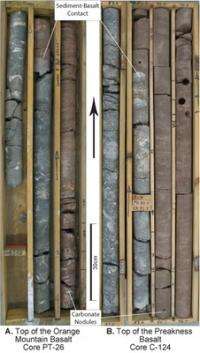Really big eruptions, lots and lots of CO2
.jpg)
(�鶹��ԺOrg.com) -- Pour enough magma out through Earth's crust, and you can change the atmosphere radically.
Twenty thousand years of massive volcanic eruptions doubled the level of carbon dioxide (CO2) in Earth’s atmosphere 200 million years ago, according to research by Rutgers geologists published recently in the journal Science.
Morgan Schaller, Jim Wright and Dennis Kent report that the level of atmospheric CO2 went from about 2,000 parts per million to 4,000 parts per million and then shrank back to pre-eruption levels over the next 300,000 years. This implies that events of this scale have the potential to rapidly double the concentration of CO2 in earth’s atmosphere. Their work, funded by a grant from the National Science Foundation, was based on measurements on cores taken from sites in northeastern New Jersey. Schaller is a PhD student, Wright an associate professor and Kent a professor of earth and planetary sciences in Rutgers’ School of Arts and Sciences.
Two-hundred million years ago, the super-continent called Pangea began to break apart, forming a rift stretching from what is now Nova Scotia to Brazil. A series of exceptionally massive volcanic eruptions, called the Central Atlantic Magmatic Province (CAMP), ensued and are now preserved in volcanic rocks spread over four continents. This rifting formed lake basins, like the Newark Basin in New Jersey, and rock cores through these ancient lake sediments preserve the lavas from the CAMP eruptions. Schaller was able to estimate the carbon dioxide content of the atmosphere using ancient soils from the Newark Rift basin – soils that formed before and after each of the eruptions. Using a mass spectrometer, he measured the carbon isotopic composition of carbonate nodules formed in these soils, which are sensitive to the concentration of CO2 in earth’s atmosphere, and reconstructed ancient atmospheric composition.

“You see these big eruptions throughout Earth’s history,” says Schaller. “But it’s always been unclear what they can do to the atmosphere. It turns out, they may do a lot.”
To a non-geologist, it might seem that any volcanic eruption might affect the atmosphere, but it’s important to understand even the largest eruptions of individual volcanoes seem puny beside the events Schaller studies – a million cubic kilometers of lava pouring out of fissures in the earth’s surface in less than 20,000 years.
“Mt. St. Helens in 1980, Mt. Pinatubo in 1991 – those were big eruptions,” Kent says. “Lots of ash and aerosols, but hardly a ripple in atmospheric CO2.”
Kent added that the famous Krakatoa eruption in 1883 occurred before regular measurements of atmospheric CO2, which began in 1958. But ice core data from that time show no detectable perturbation of atmospheric carbon dioxide.
“Where CAMP really packs a punch on the atmosphere is in the rate of volcanism,” Wright adds. “The rate of volcanism there was roughly 1,000 times the rate of volcanism that formed the Big Island of Hawaii – and keep in mind that most of Hawaii’s volume is below sea level, so it’s really higher than Mt. Everest. The key point of Morgan’s research is that the CO2 increase requires a high rate of volcanism.”
Schaller used cores taken by the U.S. Army Corps of Engineers, who took hundreds of cores in the Newark Basin as part of a plan to construct a tunnel for diversion of Passaic River flood waters in the 1980s. Schaller and his co-authors focused on these cores, along with those taken as part of the Newark Basin Coring Project with National Science Foundation funding in the 1990’s. Without the stratigraphic context of the Newark basin, and the cores archived at the Rutgers Core Repository, the discoveries of this study would not have been possible.
More information:
Provided by Rutgers University


















